MSI GE40 Review: a Slim Gaming Notebook
by Jarred Walton on July 16, 2013 3:00 AM ESTMSI GE40 Gaming Performance
Our notebook gaming suite is now set for 2013, and I'm toying with the addition of Company of Heroes 2 as a second RTS/strategy data point. We’re still collecting performance results for CoH2, however, so for now I’ll refer you to Mobile Bench for those numbers. Let's just say that the game can bring even powerful notebooks to their knees.
We’ve also got the GTX 680M courtesy of the Alienware M17x R4 in the gaming charts, along with the other notebooks from the previous page. Here are the charts, and please take the time to read the commentary before trying to draw too many conclusions as there’s more going on than may at first be apparent. We’ll start with the Value charts, where the CPU becomes even more of a factor, and then move on to the Mainstream charts.
Notebook “Value” Gaming Performance
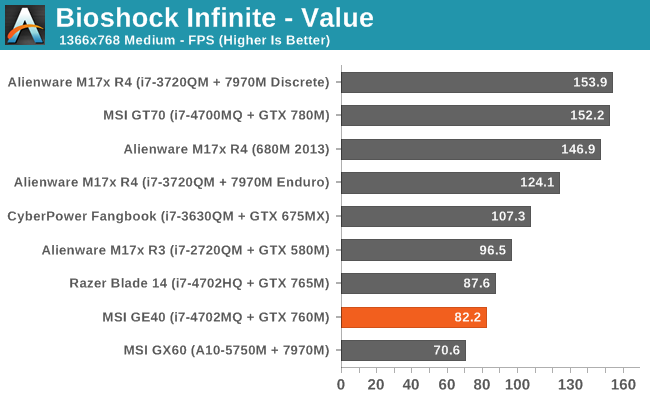
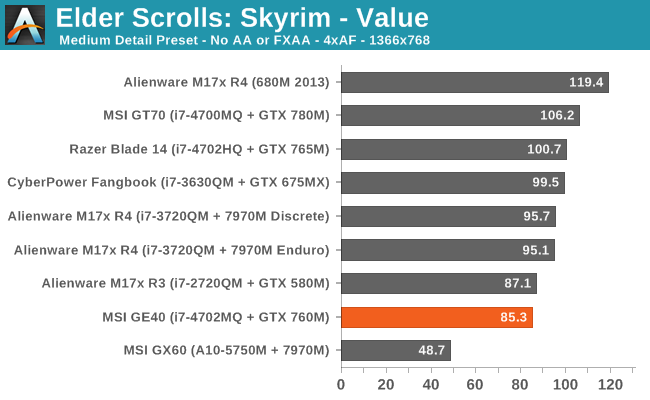
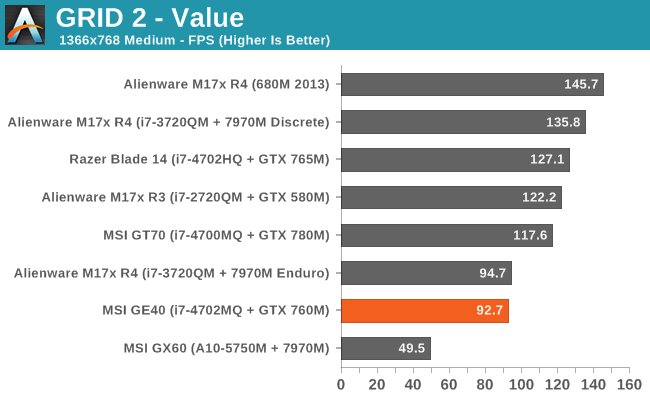
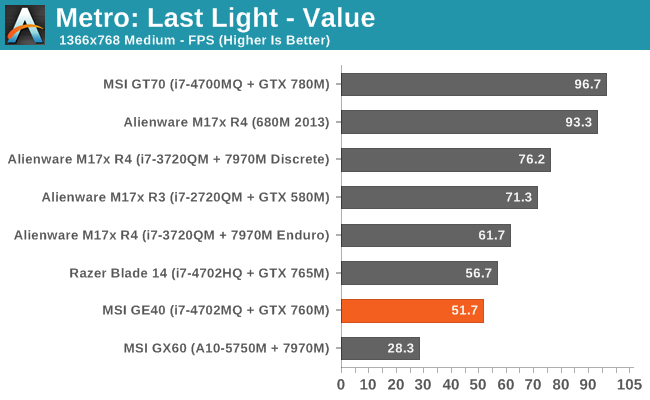
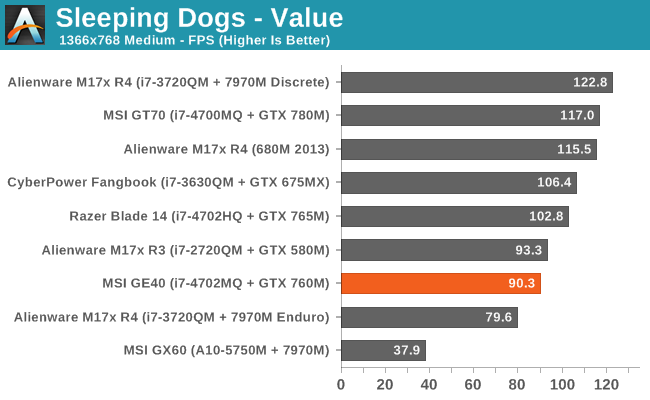
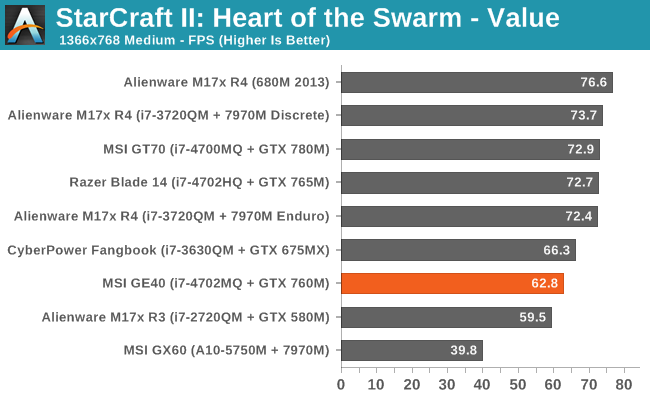
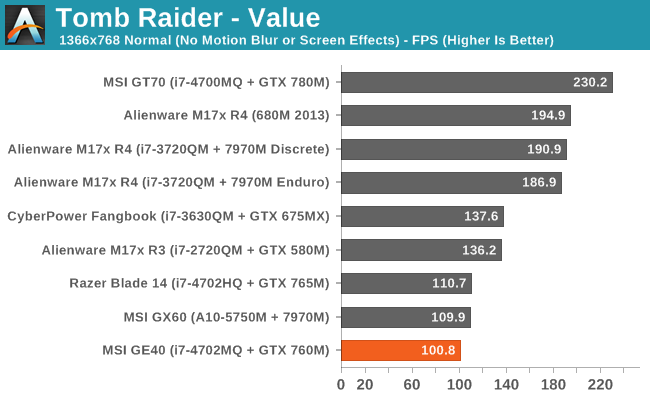
Notebook “Mainstream” Gaming Performance
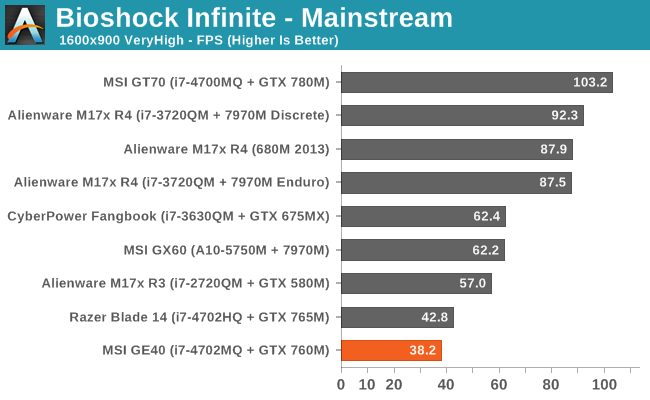

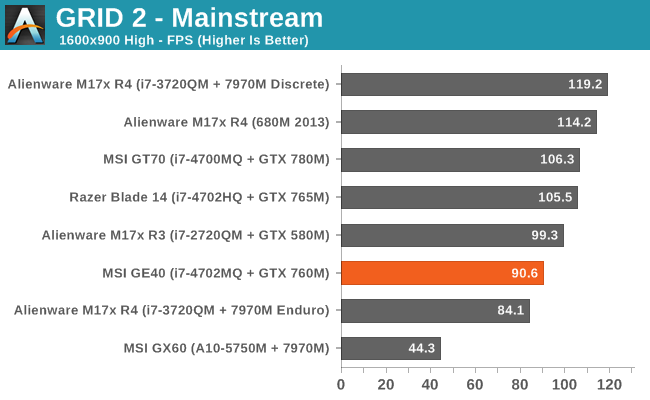
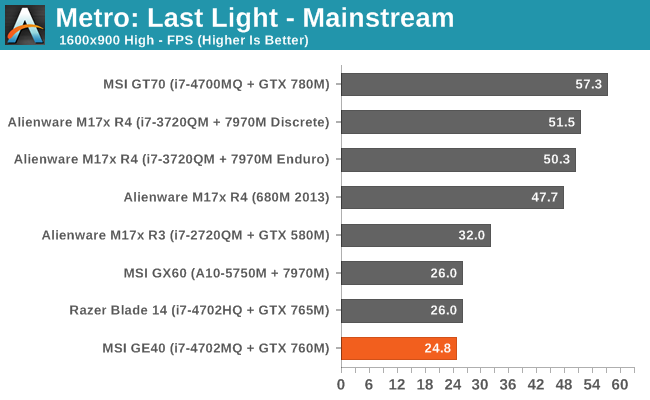
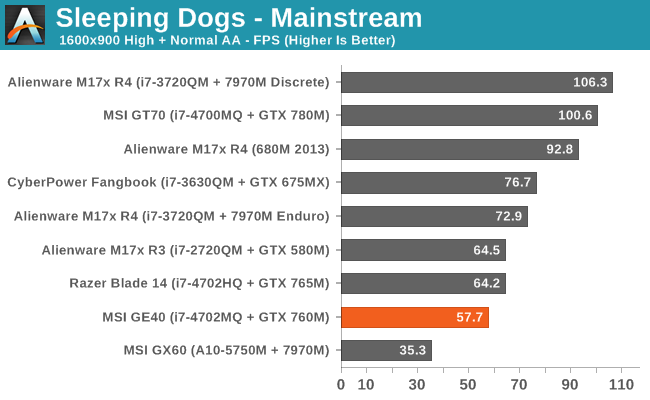
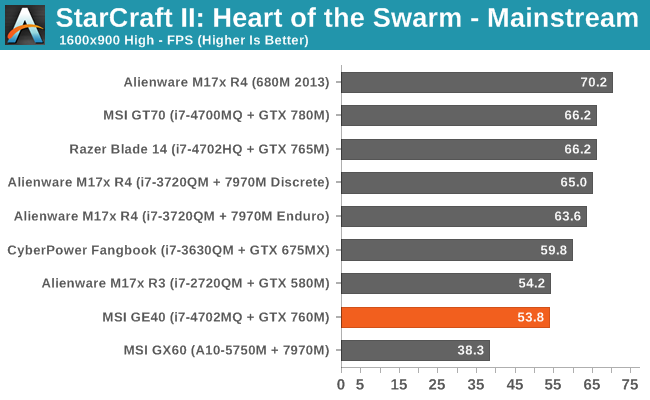
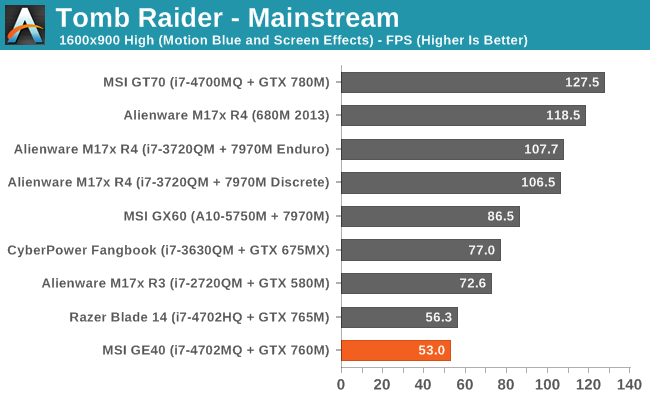
First, let me get this out of the way: the GTX 780M performance looks rather poor in many of these gaming benchmarks. The reason isn’t that our benchmarks are inherently flawed or even that the MSI GT70 is a “lemon”; rather, we’re looking at lower quality settings where the CPU plays a much greater role. We have another laptop (Clevo P157SM) with i7-4700MQ and GTX 780M, and while it’s sometimes up to 7% faster than the GT70, there are also instances where the GT70 wins by 5%; on average, our P157SM numbers average out to 0.01% faster at our Value settings and 1.3% faster at our Mainstream and Enthusiast settings.
The long and short of it is that the GTX 780M needs more CPU to really stretch its legs in some games; we’ll have a full review and investigation of CPU scaling with the GTX 780M in the future, but no matter how crazy it might seem, the results from our GT70 review aren’t far off of what you can expect in the games we’ve benchmarked at the settings we’ve used. Certain titles in particular are very CPU limited (Skyrim and StarCraft II), even at higher quality settings, and the i7-3820QM ends up being faster than the i7-4700MQ by a decent margin. (Note that the i7-4700MQ is really the replacement for the i7-3610QM, so the 3820QM is two steps above the 4700MQ.)
We can get a better idea of where the CPU matters most and where it matters least by looking at the performance of the MSI GX60. The HD 7970M is definitely faster than the GTX 760M and GTX 765M in most disciplines (e.g. look at the M17x 7970M discrete results; on average it’s 29%/41% faster than the 765M at Value/Mainstream and 50%/61% faster than the 760M), so when it loses—especially by a large margin—to the GE40, we’re looking at CPU bottlenecks. The only Value benchmark where the GX60 beats the GE40 is Tomb Raider; elsewhere it’s anywhere from 14% (Bioshock) to 58% (Sleeping Dogs) slower, and on average the GE40 runs through our Value suite 47% faster than the GX60! At the more demanding Mainstream settings, the gap narrows and the GX60 now claims wins in Bioshock, Metro: Last Light, and Tomb Raider; the GE40 is still 15% faster on average, with large wins in Skyrim, GRID 2, and Tomb Raider. It’s only at our Enthusiast settings that the GX60 starts to win in a majority of the games we’re testing. (Those scores aren’t shown here but they’re available in Bench—we figure with a 1600x900 panel and moderate GPU we didn’t need to show maxed out 1080p performance, but it’s still interesting to see how the GTX 760M handles those settings.)
Other than the GTX 780M “oddities”, the MSI GE40 places about where we’d expect. It’s always behind the Razer Blade 14, though again there appear to be cases where the Blade is hitting higher CPU turbo speeds. On paper the GTX 765M should at best provide 30% more performance than the GTX 760M (thanks to the higher core clocks). The average lead of the Razer Blade is 16% at our Value settings and 14% at our Mainstream settings, but the GRID 2 Value result is 37% faster on the Blade. Considering the increase in cost, though, that’s probably a performance tradeoff many would be willing to make.
Overall, the GE40 gets more than 60FPS in nearly every title we tested at 1366x768 Medium settings, and more than 30FPS at 1600x900 High settings. The one exception from our graphs: Metro: Last Light, where you can expect reasonable frame rates at 1600x900 Value settings but our Mainstream settings prove to be too much. Company of Heroes 2 is another brutal game, with Medium/Low 1366x768 settings getting a paltry 29FPS on the GE40 while the High/Medium 1600x900 results drop down to 23FPS. Hopefully a patch or new drivers will improve CoH2 performance—sooner rather than later—because right now the built-in benchmark can make even a GTX 780M struggle (e.g. 55FPS at our Value settings, 51FPS at Mainstream, and 23FPS at Enthusiast).










93 Comments
View All Comments
alex_l17 - Thursday, July 18, 2013 - link
actually... if you are just doing some upgrade of the RAM, MSI will still honor the warranty.. i had experience of that before. I called and spoke to the tech support, and they replied saying the RAM upgrade doesn't void warranty.xenol - Tuesday, July 16, 2013 - link
What's starting to annoy me is still, a lot of these laptops that aren't ultrabooks and whatnot, come with a VGA port. I mean, sure, a lot of external displays can take it, but it just feels very out of place. Throw in a Mini-DP and another USB port!airmantharp - Tuesday, July 16, 2013 - link
Projectors. It's sad, but it's a real limitation everywhere.JarredWalton - Tuesday, July 16, 2013 - link
Yup. There are a ton of projectors out there that pre-date HDMI and DP. It would definitely be nice to be able to run three digital displays off of a laptop, but most companies are so busy cutting corners that it's not even a minor consideration.Engineering: "For $5 extra, we can add two more digital video ouputs."
Management: "What!? Forget that -- we can save $0.05 by using 100Mbit Ethernet instead of Gigabit Ethernet. That's what we need to do! And while we're at it, find a cheaper LCD -- there's no sense spending $75 for a display that most people won't notice! All they care about are mega-whatevers and giga-things, and we need to give them lots of those. Screw abstract ideas like build quality and color accuracy...."
Bob Todd - Wednesday, July 17, 2013 - link
Hahaha...you brought up one of the things that drives me bonkers. There's no excuse for 100Mbit Ethernet STILL showing up in so many laptops. The BOM difference has to be almost non-existent these days, and yet we still see machines north of $500 only offering 100Mbit. I've seen so many machines in the past year that look kind of interesting as low cost general compute devices, then I scroll down and see "Fast Ethernet". It's like a cruel joke.Lacrimosa - Wednesday, July 17, 2013 - link
We have exactly opposing sources for annoyance :-) I am looking for these kinds of machines because I want something that I can take with me on business trips: powerful enough to game on when in hotels on evenings and good for doing my work when on client premises. I need to hold a lot of presentations so connectivity to projectors and external screens is important. Some of my collegues use these dongles to connect HDMI or some other port to those VGAs that are everywhere, but often those dongles are lost, or broken, or twist so that suddenly picture disappears... not good. I have had to pass on quite a few machines because they do not have VGA port anymore (for example that Razer Blade does not have one).yhselp - Tuesday, July 16, 2013 - link
Alright, great review in general - helpful, objective and well-written and I really mean all that. Thank you for that.However, every once in a while I come across a comment or conclusion in one of the articles I read which makes me go - whaaat?! Why did they (this is not aimed directly at Mr. Walton) write this...
I don't mean to be disrespectful, but how can you say "The truth is, we’re probably still a couple years away from seeing this level of performance in a laptop this size that runs cool and quiet;" when such a laptop exists today, not to mention your colleague review it and reached the opposite conclusion.
Not to mention the following statement or, more importantly, what it implies - "... physics can be such a drag,", yes, indeed physics not only can, but always is a drag. Why would you, however, have your audience believe that laptops such as the Razer Blade 14 and the MSI GE40 are the best thing for thermal design since heatsinks? Yes, the Razer is very well-engineered (the MSI is just bold and reckless) but neither of which pushed the envelope to the limit. I'm not trying to play wannabe thermal engineering here but if we have to talk about the facts of physics better thermal solutions for thin laptops can be designed right now, not a couple of years from now. Yes, it's easier to cool more efficient and thus cooler parts but thermal design isn't stuck, we're far from greatest in this field. The fact that it hasn't been done so far doesn't mean it's impossible. I suspect it's a matter of unwillingness/cost rather than a physics barrier. Designs such as the rMBP 15 and the Blade 14 are but a glimpse into what can be done with custom cooling solutions.
I'm sorry for this rant, but it's really unpleasant to read such a conclusion to an otherwise excellent review. I hope that at least a few people agree.
JarredWalton - Wednesday, July 17, 2013 - link
Which laptop have we reviewed that's thin, light, and powerful without running either hot and/or loud? The Razer Blade 14 hits 93C under stress testing, just slightly lower than the GE40. It could cool more with higher fan speeds, but I consider "cool and quiet" to be more like 70-80C max on the CPU and GPU with fan noise well under 40dB. We are nowhere near that level right now.The rMBP 15 is larger and while it doesn't get quite as hot, it's not exactly cool under a full load. More importantly, it's slower on the GPU than either of these laptops by a sizable gap. GT 650M is half the cores of the GTX 760M/765M -- it's not a bad GPU, but it will struggle quite a bit with higher detail gaming. I'm not trying to say any of the current designs are bad for trying, but if you want something that's as fast as the GE40 in a similar size chassis, and you don't want it to run loud or hot? It's just not going to happen right now. You either need to be thicker/larger to get more cooling, or you are going to make some noise to cope with the heat, or you're going to get hot. We've seen different laptops balance those factors to varying degrees, but really we will likely need one or two more generations of iGPU upgrades and at least one more process shrink to get to the point where we can have a combined 35W TDP for the CPU and GPU with the performance of the GTX 760M.
The Crystalwell parts from Intel offer a bit less performance than GT 650M. Maybe Broadwell can get us there, but more likely it will be Skylake -- and when Skylake arrives, we will want twice the performance of it's iGPU, just like today, in order to run all the games at acceptable levels with moderate-to-high detail settings.
yhselp - Wednesday, July 17, 2013 - link
Thank you for responding; you should know it was not my intention to be offensive. I agree with the vast majority of what you say, and I also like how you speak your mind freely and tackle different issues - $5 extra for video outputs vs. $0.05 less for Ethernet – so true. I’m not trying to question your knowledge, on the contrary – I take your professionalism for a given. It’s more of an issue of presentation and possible misinformation. Which, as I’m sure you’ll agree, is not the intended effect. It’d be unfortunate if I’m being perceived as some sort of crazy internet troll, I’m just trying to give feedback here.The thing is that your conclusion might be read and understood as ‘if you want a thin & light gaming laptop the MSI GE40 compromise is your best bet for now and that’s because it’s physically impossible to do better’. None of which is actually true (again we might be arguing linguistics here); and I’m not acting crazy, I’ve had 4 people, with and without technical knowledge, read the last page of your review and they all agree that’s a very likely interpretation.
Yes, Blade 14’s CPU goes into the lower 90s and while that’s hot, it’s not out of spec. In my opinion, there are more important factors to consider. Your colleague concluded that Blade 14’s cooling solution is quite adequate and capable of handling the heat. He also noted there’s room for improvement which is absolutely true. It’s not just a matter of raw numbers, for example, both Blade 14 and GE40 hit the 90s, however the former has a far superior cooling solution and shouldn’t have problems in the long run.
If a certain temperature doesn’t cause throttling and is safe to run at for years, and provided the surface of the product it’s in doesn’t get hot to the touch, what is the problem? No, it isn’t optimal, it isn’t perfect but it gets the job done; let’s say it’s ‘consumer-ready’. I’m not saying we should be content with running microprocessors at 90+C, but I also don’t think we should accept huge “laptops” *cough*Alienware*cough* and wait for integrated solutions to get better for ‘thin & light performance’. Besides, as you said, by the time iGPUs get at this level of performance it wouldn’t be sufficient anymore.
I also cannot accept what you seem to continually suggest – that we cannot get better cooling in the same form-factor. Getting thicker is the crudest way to better cooling performance and not the only solution. We can use denser and wider (not taller) heatsinks, bigger and more efficient fans, better materials throughout, etc. Those things would take up more space, but space management is not optimal nowadays either. We could go even further into more exotic solutions and by exotic I don’t mean crazy expensive. There’s a whole world of possibilities out there but it takes time, money and innovative engineers.
Yes, you’re correct, we probably won’t get better products right now but not because of physics.
I apologize if I’ve been a little too harsh in my quickly-written first post. I sincerely hope to get another response from you. Thank you for your time.
JarredWalton - Thursday, July 18, 2013 - link
I figure when Razer and Apple have products at $2000 and can't get cooling to the point where we think it's working ideally, it probably won't happen right now. There's definitely a balancing act and space management could be improved, but there are tradeoffs with changing the way space is used as well. Go with mSATA or M.2 SSDs for instance and you drastically limit what options are available. Better fans and heatsinks are certainly a possibility, which is something I hope a revised GE40 would look into, but that's probably a 5C or maybe 10C difference at best.Anyway, I've tweaked the conclusion a bit to make it clear where I think the GE40 stands. Razer is a bit cooler, quieter, faster...and a lot more expensive. Both need better displays. GE40 also needs improved industrial design IMO. Long-term, the Razer is less likely to have problems I think, but what I've learned over the years is that "long-term" is very hard to judge. Fans can fail on expensive as well as cheap laptops, and while I'd hope the fans used in more expensive laptops would last longer... well, I wouldn't make a bet on that! (I have had plenty of $400-$500 GPUs that had fans wear out after a year or two.)
So which laptop is truly "better" out of the Blade 14 and GE40? Probably the Blade, but roughly $700 extra to get there makes it pretty much a wash in my book. If the Blade had an IPS panel, then it would be just about perfect -- expensive, yes, but with no huge flaws. The GE40 needs far more work before it could get the same sort of recommendation.